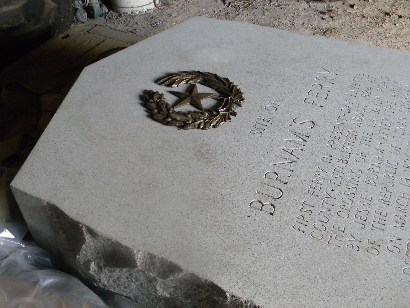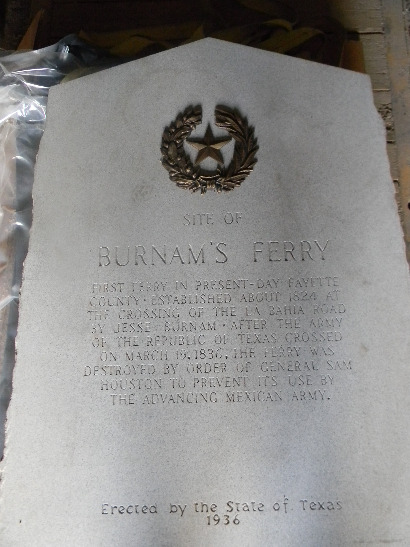|
|
It
started with taped-together scraps of topographical map quadrants
found in the Winedale archives: a Native American archeological site
marked in red on a terrace of Ross’ Creek where it formerly joined
the Colorado River.
Ross’ Creek is the next small drainage east of Cedar Creek, which
forms Lake Fayette. The creek now runs down the southern loop of a
cut off oxbow, and joins the river near the top of pioneer ferryman
Jesse Burnam’s original league; the Indian site on the Ellinger
side has probably been destroyed by gravel mining). |
 |
Hello,
what’s this? On another terrace, on the western side of the river,
a small “x” in a circle and the words “Historical Marker.” What historical
place or event could it commemorate to appear on a 50 year old USGS
toporaphical map?
A physical search revealed the marker was no longer in the indicated
location on the old Burnam homeplace near Holman.
What could have happened to it?
A combination of research at the Fayette County Archives and consultation
with Nesbitt Memorial Library (in Columbus)
director Bill Stein
revealed a partial answer to the mystery.
The
missing monolith was a grey granite 1936 Centennial marker signifying
Burnam’s Ferry, where Sam
Houston, leading the rag-tag Texas Army and a bunch of terrified
settlers fleeing Santa Anna’s armies, had crossed the flooding Colorado
River on their way east in early 1836.
Burnam’s Ferry was a “gravel-bottomed ford.” The ferryboat was for
high water. Jesse Burnam, an early Austin colonist, had erected quite
a station, according to early observers, with a fine two-story brick
house and store. He was a veteran of numerous fights with local Indians
and, generally-speaking, not a man to mess with.
The crossing was on a cutoff of the La
Bahia Road, the main branch of which crossed the river at La
Grange. After crossing his army, Houston
ordered Burnam’s station burned, boat and all. Burnam never forgot.
When the State of Texas placed markers at significant historical sites
prior to the 1936 Texas Centennial,
local historian Houston Wade pointed out the site of Houston’s crossing
of the Colorado at Burnam’s. Duly installed, the marker stayed put
until 197?, when something happened to prove the adage: “historians
love to disagree.”
A
couple of avocational local historians, one from Weimar
and another from La Grange,
decided that Houston Wade (and Julia Lee Sinks) were just wrong when
they identified the original site of Burnam’s crossing. They thought
it should have been several miles south at the other end of Burnam’s
original league. (Possible source of the confusion: Burnam did move
to the other end of his property after the Texas Revolution and probably
had a ferry there).
Getting a verbal OK from the Fayette County judge at the time and
enlisting the financial assistance of Colorado County commissioners,
the two revisionists engineered the removal of the monument to Colorado
County where the original inscription was ground off and replaced
with language locating the crossing site near Weimar (suspiciously
near the birthplace of the Colorado County man).
There it remained until three years ago, a landmark shown to generations
of Colorado County youth as Houston’s
crossing place. This despite Bill
Stein’s statement that, “I don’t know anyone who thinks it’s in
the right place.”
Let Fayette County Historical Commission chair Linda Dennis take up
the story:
“Thanks
to the Fayette County Record, a story was written about the missing
monument almost three years ago. The Fayette County Historical Commission
immediately began the task of bringing it home where it belongs. Not
only had the monument been moved, but the verbiage had been changed
to reflect another county’s information. It took over a year to get
special permission from the Texas Historical Commission in Austin
to allow for a unique twist in handling the Burnam Ferry Monument.”
Dennis explained that the THC decided that the Colorado County information,
even if incorrect, had became part of the history of the monument.
(It had, after all, been on the monument longer than the actual Fayette
County text).
After much deliberation and persistence by Dennis and County Judge
Ed Janecka,, the THC agreed to allow the monument to become the only
two-sided 1836 Centennial marker in the State of Texas.
“Notably, the Fayette County side will become the new front side and
will include a ‘Returned to’ date,” Dennis said. The bootleg revision
on back side will retain the (incorrect) Colorado County information
which was incised after the original inscription had been ground off.
(“Bootleg,” because the marker properly belongs to the state, which
did not give permission for its removal or alteration).
After what Dennis calls “a long and winding road,” the monument was
brought back to the county late last week.
Some
stages on that road were:
In 2009, the
county reacquired the monument and moved it to Austin,
from whence it made another move to Marble
Falls to have the “back” (new “front”) refinished and polished.
It was then
taken to Stasswender Memorials, where the freshly polished stone
was etched with the original information about the significance
of the ferry crossing.
Dennis again:
“All that was left to do at this point was to place a wreath and
star on the monument. That sounds like a simple task but the new
wreaths and stars are different and made with shiny brass. It took
a long time to find a company that could create an old one and match
the patina of the one on the other side.”
Then, about
six weeks ago, Rodriquez Brothers Memorials in San
Antonio was commissioned to make the wreath and star. Last
week, Dennis delivered the completed wreath and star to the foundry
where they were attached to the monument.
“Not only will this be the only two-sided Centennial monument in
the State, but it will probably be the most traveled,” Dennis said.
Plans
are for members of the Holman and Burnam families to attend rededication
ceremonies in early October, along with area 7th-graders who are
studying Texas history and members of the public.
Sidebar: Donations are needed to help pay for the Burnam
Ferry Re-Dedication Ceremonies and a Reception. Please contact:
Linda Dennis, Chairman, Fayette County Historical Commission at:
Linda_J_Dennis@yahoo.com or call (979) 378-2019 if you can help.
The original verbiage on the monument is below:
BURNAM’S FERRY
FIRST FERRY IN PRESENT-DAY FAYETTE COUNTY. ESTABLISHED ABOUT 1824
AT THE CROSSING OF THE LA BAHIA ROAD BY JESSE BURNAM. AFTER THE
ARMY OF THE REPUBLIC OF TEXAS CROSSED ON MARCH 19, 1836, THE FERRY
WAS DESTROYED BY ORDER OF GENERAL SAM HOUSTON TO PREVENT ITS USE
BY THE ADVANCING MEXICAN ARMY.
- The Fayette County Record, La Grange
July 2011
|
 |
Burnham's
Ferry Texas Centennial Marker
TE Photo, July 2011 |
| Texas
Escapes, in its purpose to preserve historic, endangered and vanishing
Texas, asks that anyone wishing to share their local history, stories,
landmarks and vintage/historic photos, please contact
us. |
|
|
